
Repotting indoor plants is an essential part of caring for them and ensuring their growth and health. Neglecting to repot can lead to wilted leaves, stunted growth, and dry soil. To maintain thriving indoor plants, it is recommended to repot them every one to two years, depending on their size and growth rate.
Repotting provides more room for the roots to grow and prevents the soil from becoming depleted of moisture and nutrients. Timing is crucial for successful repotting, with the best time being in the spring when plants are entering their active growing season.
This is when they benefit from longer days and more intense sunlight, aiding in their recovery from transplanting and promoting growth.
When repotting, it’s important to select a new pot that is slightly larger than the current pot to allow for growth. Choosing a pot with drainage holes is essential to prevent waterlogging and root rot. Also, using a potting mix specifically designed for indoor plants will provide the right balance of nutrients and moisture.
Key Takeaways:
- Repotting indoor plants every one to two years promotes their growth and health.
- The best time to repot indoor plants is in the spring, during their active growing season.
- Choose a pot that is slightly larger than the current pot and has drainage holes.
- Use a potting mix specifically designed for indoor plants for optimal nutrient balance.
- Proper repotting techniques help ensure the successful growth and health of indoor plants.
Signs that your indoor plants need repotting
Knowing when to repot your indoor plants is crucial for their health and growth. There are several signs that indicate it may be time to repot your plants:
- The roots are growing through the drainage holes at the bottom of the pot.
- The roots are pushing the plant up and out of the pot.
- The plant is growing slower than usual.
- The potting mix dries out quickly.
- The plant becomes top-heavy and prone to falling over.
- Visible salt and mineral buildup on the plant or pot.
- It has been over a year since you last repotted the plant.
If you notice any of these signs, it is likely time to repot your indoor plants and provide them with fresh soil and more room for root growth.
Signs that your indoor plants need repotting
| Signs | Action |
|---|---|
| Roots growing through drainage holes | Repot the plant into a larger pot |
| Roots pushing the plant up and out of the pot | Repot the plant into a larger pot |
| Slow growth | Repot the plant into fresh soil |
| Potting mix drying out quickly | Repot the plant into fresh soil |
| Plant becoming top-heavy and prone to falling over | Repot the plant into a larger pot |
| Visible salt and mineral buildup | Repot the plant into fresh soil |
| Over a year since last repotting | Repot the plant into fresh soil |
By paying attention to these signs, you can ensure that your indoor plants are thriving and have the space they need to grow.
The Best Time to Repot Indoor Plants
Timing is crucial when it comes to repotting indoor plants. The best time for repotting is in the spring, when plants are entering their active growing season.
During this time, plants benefit from the longer days and more intense sunlight, which helps them recover quickly from transplanting and promotes growth. This is especially important for indoor plants, as they tend to thrive when repotted during this time of year.
H3:
- Benefits of repotting during the active growing season
- Importance of outdoor conditions for indoor plants
- Promotion of healthy growth and development
Repotting during the spring allows plants to take advantage of the natural growth cycle and optimizes their chances of thriving. The longer days and increased sunlight provide the necessary energy for plants to recover from the transplanting process.
It also helps stimulate new root growth and encourages overall healthy development. By repotting during the active growing season, you give your indoor plants the best opportunity to establish themselves in their new pots and continue to flourish.
Benefits of Repotting During the Active Growing Season
| Benefit | Description |
|---|---|
| Promotes quicker recovery | The longer days and more intense sunlight help plants recover faster from transplanting. |
| Stimulates new root growth | The natural growth cycle during the active growing season encourages the development of new roots. |
| Supports overall healthy growth | Repotting during this time provides plants with the necessary conditions to thrive and develop. |
By repotting your indoor plants in the spring, you ensure that they have the best chance of success and continued growth. This is a key factor in maintaining the health and vitality of your indoor greenery.
Choosing the Right Pot for Repotting Indoor Plants
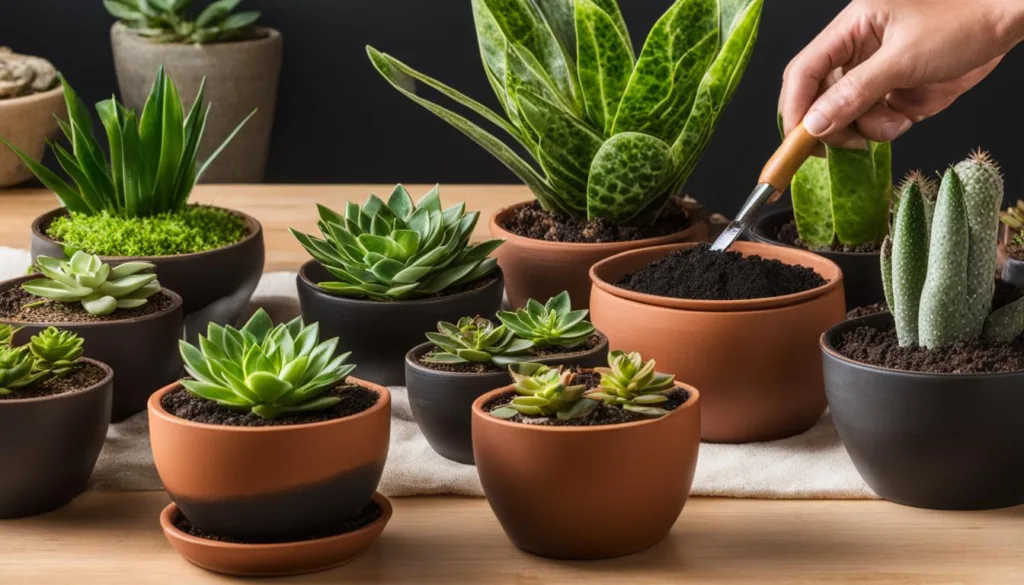
When it comes to repotting indoor plants, selecting the right pot is crucial for their overall health and growth. The size, material, and drainage capabilities of the pot all play a significant role in providing the ideal environment for your plants to thrive.
Size Matters:
When choosing a new pot for repotting, it is important to select one that is slightly larger than the current pot. This allows room for the roots to grow without overwhelming the plant.
A pot that is too large can lead to overwatering and root rot, while a pot that is too small restricts root growth and can stunt the plant’s development. Assess the size of your plant and choose a pot accordingly.
Material Considerations:
There are several materials to choose from when it comes to pots for indoor plants. Plastic pots are lightweight, affordable, and retain moisture well. Terra cotta pots are porous, allowing for better airflow to the roots, but they can also absorb moisture quickly, requiring more frequent watering.
Ceramic pots are stylish and come in a variety of designs, but they tend to be heavier and require careful watering to prevent waterlogging. Consider the specific needs of your plants and your personal aesthetic preferences when selecting a pot material.
Drainage is Key:
One of the most important factors to consider when choosing a pot for repotting is drainage. Ensure that the pot has multiple drainage holes at the bottom to allow excess water to escape.
This prevents waterlogging and root rot, which can be detrimental to your plant’s health. If you fall in love with a pot that doesn’t have drainage holes, you can place a layer of gravel or pebbles at the bottom to create a reservoir for excess water.
| Pot Material | Pros | Cons |
|---|---|---|
| Plastic | Lightweight, affordable, retains moisture well | Does not allow for proper airflow, less aesthetically pleasing |
| Terra Cotta | Porous, promotes better airflow to the roots | Dries out quickly, requires more frequent watering |
| Ceramic | Stylish, available in a variety of designs | Heavy, requires careful watering to prevent waterlogging |
Choosing the right pot for repotting indoor plants is essential for their overall well-being. Consider the size, material, and drainage capabilities of the pot to create an optimal environment for your plants to thrive.
Selecting the Appropriate Potting Mix for Repotting Indoor Plants
When it comes to repotting indoor plants, choosing the right potting mix is essential for their overall health and growth. A suitable potting mix provides the necessary nutrients, moisture retention, and proper drainage for optimal plant development.
Here, I will guide you through the factors to consider and the best potting mix options for repotting your indoor plants.
Factors to Consider
Before selecting a potting mix, it is important to consider the specific needs of your indoor plants. Some plants, such as succulents and cacti, require well-draining soil to prevent root rot.
Others, like orchids, thrive in a mix that provides excellent air circulation. It is crucial to match the potting mix to the plant’s characteristics for successful repotting.
Additionally, consider the moisture retention capabilities of the potting mix. Some indoor plants require a mix that retains moisture for a longer duration, while others prefer a mix that allows the soil to dry out more quickly. Understanding your plant’s moisture needs will help you choose the right potting mix.
Best Potting Mix Options
Here are some of the best potting mix options for repotting your indoor plants:
| Potting Mix | Description |
|---|---|
| Standard Potting Mix | A general-purpose potting mix suitable for a wide range of indoor plants. It provides good drainage and moisture retention. |
| Succulent and Cacti Mix | A well-draining mix specifically formulated for succulents and cacti. It helps prevent overwatering and root rot. |
| Orchid Mix | A mix designed for orchids, typically containing bark, charcoal, and perlite. It provides excellent air circulation and drainage. |
| Peat Moss Mix | A mix that contains peat moss, which retains moisture well. It is suitable for plants that prefer slightly moist soil. |
Remember to adjust the potting mix depending on your plant’s specific requirements. Some plants may benefit from a mixture of different potting mixes to achieve the perfect balance of nutrients, moisture, and drainage.
By selecting the appropriate potting mix for repotting your indoor plants, you can provide them with the ideal growing environment and set them up for success. Remember to consider your plant’s needs and choose a mix that promotes healthy root development and overall plant growth.
Steps to Repotting Indoor Plants
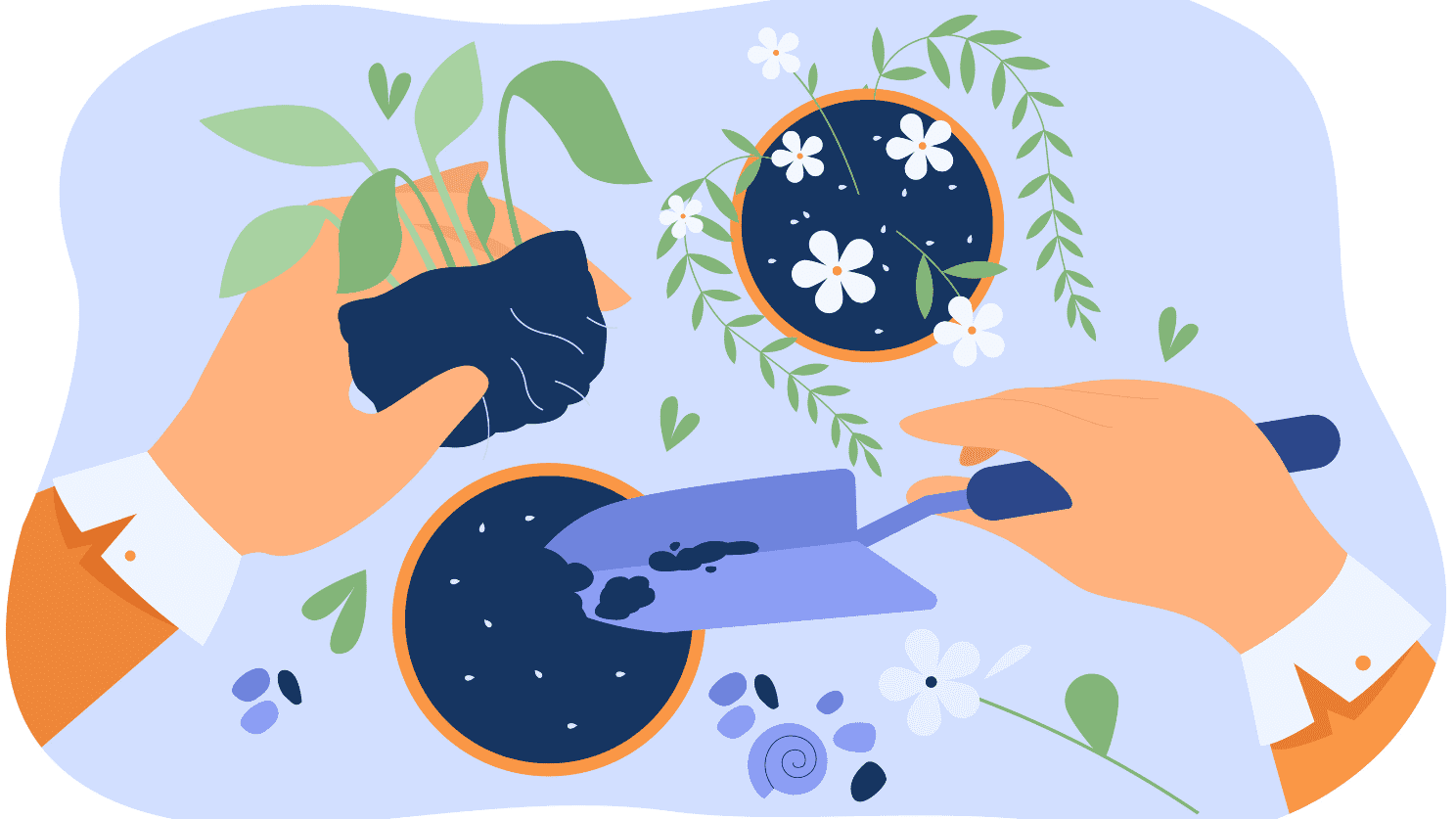
Repotting indoor plants is a simple process that can be completed in a few easy steps. Following these steps will ensure that your plants are properly repotted and have the best chance of thriving in their new pots.
Gather Your Materials
Before you begin repotting your indoor plants, gather all the necessary materials. You will need a new pot, potting mix, a watering can, and a trowel or small shovel to help with the process. Having everything you need on hand will make the repotting process much smoother.
Water the Plant
Before removing the plant from its current pot, water it thoroughly. This will help to loosen the soil and make it easier to remove the plant without causing damage to the roots. Allow the excess water to drain out before proceeding.
Remove the Plant from the Pot
Gently slide the plant out of its current pot, being careful not to damage the roots. If the plant is stuck, you can use a knife to gently loosen the edges of the pot. Once the plant is free, gently shake off any excess soil and inspect the roots. Trim any dead or damaged roots with clean scissors or pruning shears.
Prepare the New Pot
Place a layer of fresh potting mix at the bottom of the new pot. The layer should be thick enough to provide a good foundation for the plant but not so thick that it suffocates the roots.
Position the plant in the center of the pot and carefully fill in the remaining space with potting mix, gently tamping it down to remove air pockets. Leave a small gap between the top of the soil and the rim of the pot to allow for watering.
Once the plant is securely planted in its new pot, water it thoroughly. Allow the excess water to drain out before placing the repotted plant in a well-lit area. With proper care and regular watering, your repotted indoor plants will continue to grow and thrive in their new homes.
Tips for Successful Repotting of Indoor Plants
When it comes to repotting indoor plants, following a few tips can greatly increase your chances of success. These tips will help ensure that your plants adjust well to their new pots and continue to thrive:
- Patience is key: Avoid rushing to repot your plants. Give them time to grow into their current pots before moving them to a larger one. This will prevent the risk of overwatering and root rot.
- Choose the right pot size: When repotting, select a pot that is only slightly larger than the current one. This will provide enough space for the roots to grow without overwhelming the plant.
- Use a well-draining potting mix: Opt for a potting mix specifically designed for indoor conditions. This type of soil allows for proper drainage and prevents waterlogged roots.
- Handle plants with care: Some plants have irritating sap or thorns. Wear gloves when repotting these plants to protect your hands.
- Water before repotting: Watering the plant before repotting will help loosen the soil and make it easier to remove from the pot.
- Wash the new pot: Before placing your plant in the new pot, make sure to wash it to remove any residue that could potentially harm the plant.
By following these tips, you can ensure a smooth and successful repotting process for your indoor plants, allowing them to continue thriving in their new pots.
| Tips for Successful Repotting of Indoor Plants |
|---|
| 1. Patience is key Avoid rushing to repot your plants. Give them time to grow into their current pots before moving them to a larger one. This will prevent the risk of overwatering and root rot. |
| 2. Choose the right pot size When repotting, select a pot that is only slightly larger than the current one. This will provide enough space for the roots to grow without overwhelming the plant. |
| 3. Use a well-draining potting mix Opt for a potting mix specifically designed for indoor conditions. This type of soil allows for proper drainage and prevents waterlogged roots. |
| 4. Handle plants with care Some plants have irritating sap or thorns. Wear gloves when repotting these plants to protect your hands. |
| 5. Water before repotting Watering the plant before repotting will help loosen the soil and make it easier to remove from the pot. |
| 6. Wash the new pot Before placing your plant in the new pot, make sure to wash it to remove any residue that could potentially harm the plant. |
Following these tips will not only make the repotting process smoother but also increase the chances of your indoor plants thriving in their new pots.
Repotting Considerations for Specific Types of Indoor Plants
When it comes to repotting indoor plants, different types have specific requirements that need to be considered for successful transplanting. Here are some repotting tips for specific houseplants:
Succulents and Cacti:
When repotting succulents and cacti, it is crucial to use a well-draining soil mix specifically formulated for these drought-tolerant plants. The mix should contain ingredients like perlite, sand, and pumice to ensure proper drainage and prevent root rot. Additionally, choose a pot that is just slightly larger than the current one to avoid excess moisture retention.
Orchids:
Orchids require a specialized orchid potting mix that contains bark, charcoal, and perlite. This mix provides adequate drainage and allows air circulation around the roots, which is essential for orchids’ overall health. When repotting orchids, it is important to gently remove old potting material and inspect the roots for any signs of damage or disease.
Ferns and Leafy Houseplants:
Ferns and leafy houseplants generally prefer a potting mix that contains organic matter, such as peat moss or compost, to retain moisture. These plants thrive in a slightly more moisture-retentive environment, but it is still important to ensure good drainage to prevent waterlogging. Choose a pot that allows excess water to escape and avoid overwatering after repotting.
| Plant Type | Recommended Potting Mix | Potting Tips |
|---|---|---|
| Succulents and Cacti | Well-draining mix with perlite, sand, and pumice | Choose a slightly larger pot; avoid excess moisture |
| Orchids | Specialized orchid mix with bark, charcoal, and perlite | Inspect roots for damage; provide good air circulation |
| Ferns and Leafy Houseplants | Moisture-retentive mix with organic matter | Ensure good drainage; avoid overwatering |
By considering the specific needs of different indoor plants during repotting, you can help them thrive in their new environment. Remember to research the requirements of your specific plant species and provide the appropriate potting mix and pot size to support healthy growth.
Common Mistakes to Avoid When Repotting Indoor Plants
Repotting indoor plants is a straightforward task, but there are some common mistakes that should be avoided to ensure the health and success of your plants. Here are some common errors in repotting houseplants and how to avoid them:
1. Using a Pot That Is Too Large
One of the most common mistakes in repotting indoor plants is choosing a pot that is too large. While it may seem logical to give your plant plenty of space to grow, an oversized pot can lead to overwatering and root rot. Instead, choose a pot that is only slightly larger than the current one, allowing room for growth without overwhelming the plant.
2. Neglecting Proper Drainage
Proper drainage is essential for the health of your indoor plants. Without adequate drainage, water can become trapped in the pot, leading to waterlogged soil and root rot. When repotting, make sure to select a pot with drainage holes and use a well-draining potting mix. This will allow excess water to drain away, preventing moisture-related issues.
3. Planting Too Deep
Planting your repotted plant too deep can lead to waterlogged roots and hinder its growth. To avoid this mistake, make sure to position the plant at the same depth as it was in its previous pot. The soil line should be just below the rim of the pot, allowing the plant to breathe and preventing water from pooling around the stem.
By avoiding these common mistakes, you can ensure a successful repotting process and keep your indoor plants healthy and thriving.
| Mistake | Consequence | Solution |
|---|---|---|
| Using a Pot That Is Too Large | Overwatering, root rot | Choose a pot that is slightly larger than the current one |
| Neglecting Proper Drainage | Waterlogged soil, root rot | Use a pot with drainage holes and well-draining potting mix |
| Planting Too Deep | Waterlogged roots, hindered growth | Position the plant at the same depth as in the previous pot |
Tips for Caring for Newly Repotted Indoor Plants
After repotting your indoor plants, it’s important to provide them with proper care to help them thrive in their new environment. Here are some essential tips for caring for your repotted houseplants:
1. Avoid Overwatering
One of the most common mistakes after repotting is overwatering the plants. Allow the soil to dry slightly between waterings to prevent root rot. Stick your finger into the soil about an inch deep, and if it feels dry, it’s time to water. Remember that different plants have different water requirements, so adjust accordingly.
2. Monitor for Signs of Stress
After repotting, plants may experience some stress or shock. Keep a close eye on them for any signs, such as wilting or drooping leaves. If you notice any stress symptoms, adjust the watering and lighting conditions as needed. Give your plants some time to adjust to their new pots before making any further changes.
3. Provide Adequate Lighting
Place your repotted plants in a well-lit area, but avoid direct sunlight immediately after repotting. Give them some time to acclimate to their new pots before exposing them to intense light. Gradually increase the light exposure over time to prevent sunburn on the delicate leaves.
4. Regularly Inspect for Pests and Diseases
Keep a close eye on your repotted plants for any signs of pests or diseases. Inspect both the leaves and the soil for any unusual spots, discoloration, or pest activity. If you notice any issues, take appropriate action immediately to prevent further damage and ensure the health of your plants.
By following these aftercare tips, you can provide the necessary support for your newly repotted indoor plants. Remember to be patient and observe your plants closely to tailor your care to their specific needs. With time and proper care, your repotted houseplants will continue to grow and thrive in their new pots.
Benefits of Repotting Indoor Plants
Repotting indoor plants offers several advantages that contribute to their overall health and growth. When plants are repotted, their roots are given more space to spread out and grow. This allows for better nutrient absorption and promotes stronger root development. By providing the optimal conditions for root growth, repotting contributes to the overall well-being of the plant.
Another benefit of repotting is the prevention of soil depletion. Over time, the soil in the original pot can become compacted and depleted of essential nutrients. Repotting provides fresh soil that is rich in nutrients, ensuring that the plant has access to the necessary resources for continued growth and vitality.
Additionally, repotting allows for the inspection and removal of damaged or diseased roots. When repotting, it is an opportunity to visually assess the health of the plant’s root system. Removing any damaged or diseased roots can help prevent the spread of diseases and promote a healthier plant overall.
| Advantages of Repotting Indoor Plants |
|---|
| Enhanced root growth and nutrient absorption |
| Prevention of soil depletion |
| Opportunity to inspect and remove damaged roots |
As a result, repotting indoor plants is a crucial maintenance task that contributes to their long-term health and thriving growth. By providing more space for root development, replenishing soil nutrients, and addressing any root issues, repotting ensures that indoor plants have the best conditions for growth and vitality.
Repotting indoor plants is an essential aspect of their care and maintenance. By following the best methods for repotting, you can ensure the health and growth of your houseplants while preventing soil depletion.
Remember to repot your plants every one to two years, providing them with adequate space for root growth and preventing the soil from becoming depleted of moisture and nutrients.
When repotting, choose a pot that is slightly larger than the current one to allow room for growth. Ensure that the pot has drainage holes to avoid waterlogging and root rot.
Use a potting mix specifically designed for indoor plants to provide the right balance of nutrients and moisture.
Timing is crucial when repotting indoor plants, with the best time being in the spring when plants are entering their active growing season. This allows them to recover quickly from transplanting and promotes vigorous growth.
After repotting, provide appropriate aftercare by adjusting watering, ensuring proper lighting, and monitoring for any signs of stress or pest infestation.
By following these methods and guidelines, you can successfully repot your indoor plants and enjoy the benefits of healthier and thriving greenery in your home. So go ahead and give your houseplants the care they deserve by repotting them at the right time and with the proper techniques.
FAQ
What are the best methods for repotting indoor plants?
The best methods for repotting indoor plants include choosing the right time, selecting the appropriate pot and potting mix, and following the proper steps for repotting. It is also important to avoid common mistakes and provide proper aftercare for newly repotted plants.
What are the signs that my indoor plants need repotting?
Signs that your indoor plants need repotting include roots growing through the drainage holes, slow growth, quick drying of the potting mix, the plant becoming top-heavy, and visible salt and mineral buildup. If it has been over a year since you last repotted your plant, it is likely time to do so.
When is the best time to repot indoor plants?
The best time to repot indoor plants is in the spring when they are entering their active growing season. During this time, plants benefit from the longer days and more intense sunlight, which helps them recover quickly from transplanting and promotes growth.
How do I choose the right pot for repotting indoor plants?
When choosing a pot for repotting indoor plants, it is important to select one that is slightly larger than the current pot to allow for growth. The pot should also have drainage holes to prevent waterlogging and root rot. Plastic, terra cotta, and ceramic containers are good options for indoor plants.
What potting mix should I use for repotting indoor plants?
For repotting indoor plants, it is important to use a potting mix specifically designed for indoor conditions. This type of soil provides the right balance of nutrients and moisture. A loose and porous potting mix with ingredients like bark, charcoal, and perlite is ideal for indoor plants as it aids in drainage and water retention.
What are the steps to repotting indoor plants?
The steps to repotting indoor plants include watering the plant before removing it from its current pot, gently sliding the plant out of the pot, removing excess soil and trimming roots if necessary, placing a layer of potting mix in the new pot, positioning the plant in the center, filling in the remaining space with potting mix, and watering thoroughly.
What are some tips for successful repotting of indoor plants?
Some tips for successful repotting of indoor plants include not rushing to repot, choosing a pot only slightly larger than the current pot, using a well-draining potting mix, watering the plant before repotting, and washing the new pot before use. Different plants may have specific requirements, so it’s important to research their needs.
Are there specific considerations for repotting different types of indoor plants?
Yes, different types of indoor plants may have specific considerations when it comes to repotting. For example, succulents and cacti require well-draining soil, while orchids require a specialized orchid potting mix. Leafy houseplants may benefit from a mix that contains organic matter for moisture retention. Researching the specific needs of your plants is important.
What are some common mistakes to avoid when repotting indoor plants?
Common mistakes to avoid when repotting indoor plants include using a pot that is too large, not providing proper drainage, planting the repotted plant too deep, and over-fertilizing after repotting. Following the proper repotting techniques and avoiding these mistakes will help ensure the successful growth and health of your indoor plants.
What are some tips for caring for newly repotted indoor plants?
When caring for newly repotted indoor plants, it is important to avoid overwatering and allow the soil to dry slightly between waterings. Monitor the plant for signs of stress or shock, keep it in a well-lit area, and give it time to adjust to its new environment before providing additional fertilization. Regularly check for pests or diseases and take appropriate action if necessary.
What are the benefits of repotting indoor plants?
Repotting indoor plants provides benefits such as allowing the roots more room to grow, preventing soil depletion, and visual inspection of the roots. It also promotes better nutrient absorption and overall plant health. Repotting is an important maintenance task that helps keep indoor plants thriving.

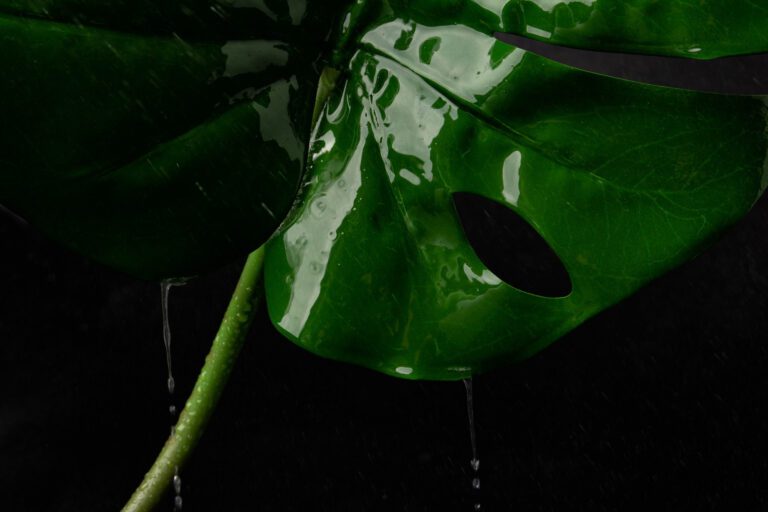
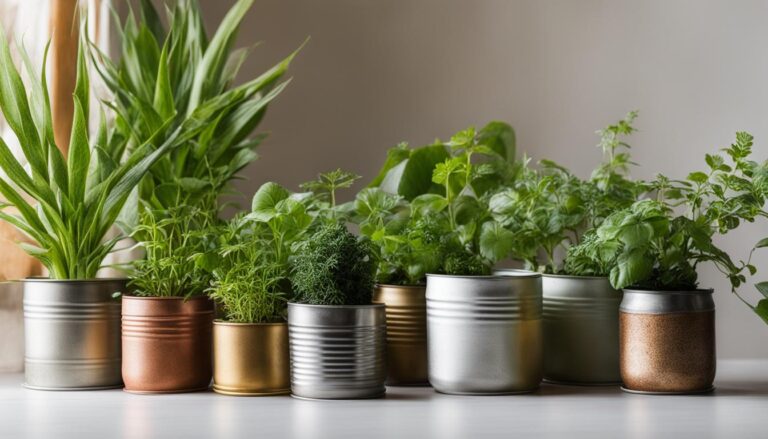
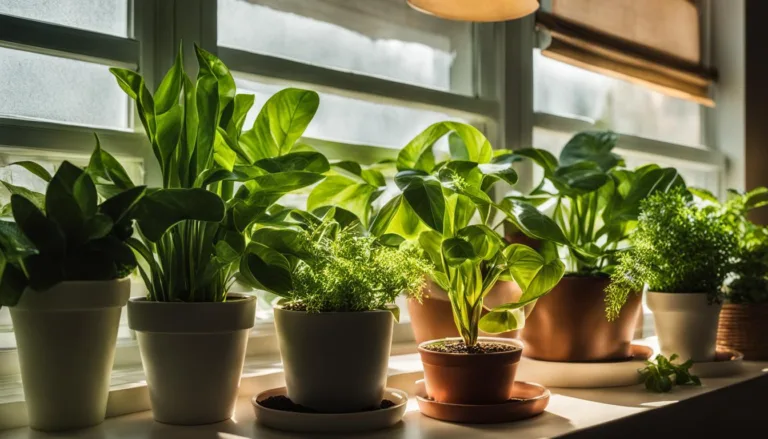
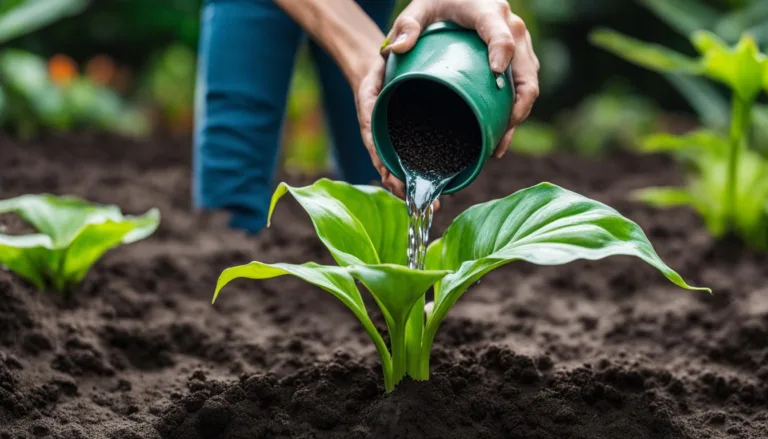
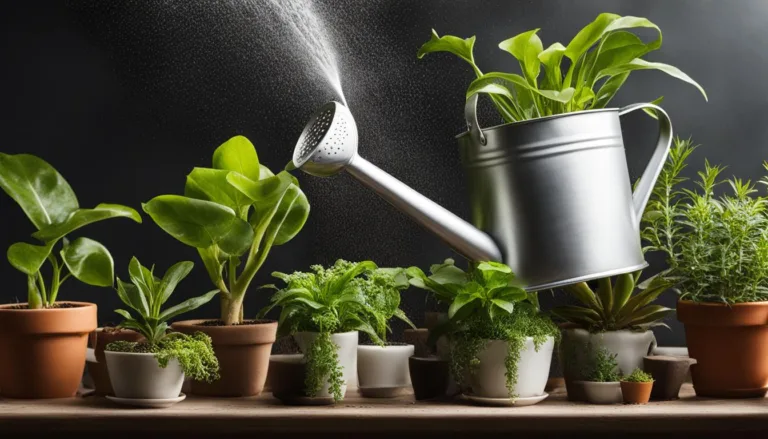
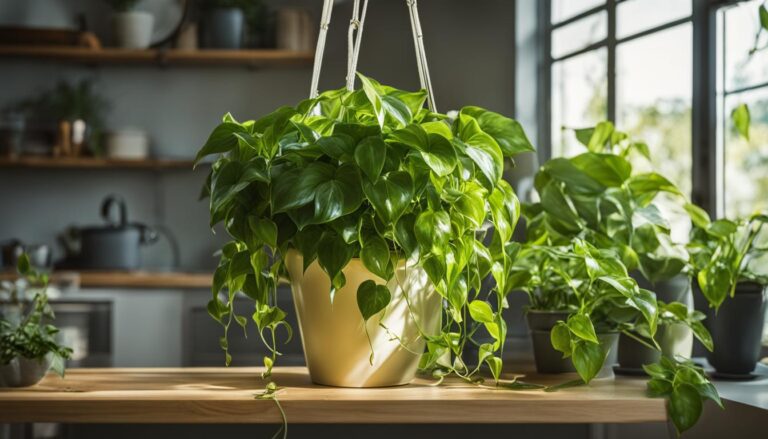
2 Comments
Comments are closed.